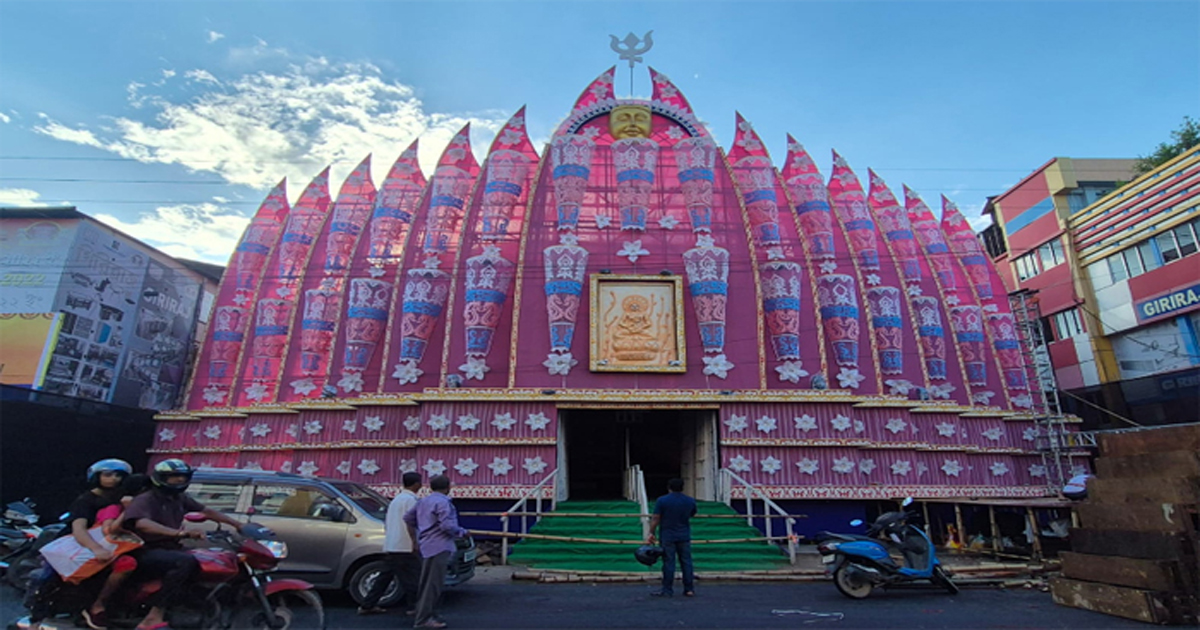‘Durga Puja’ : themes, images and interventionist politics
By Our Correspondent
Agartala, October 3, 2025
 The worship of ‘Debi Durga’, Hindu Goddess of might and victory over evil forces, had commenced in timeless antiquity. Amongst the plethora of myths, legends and epic tales surrounding the worship of the Mother Goddess, what stands out is that Lord Sri Rama had ritually worshipped the Mother Goddess before his decisive battle with the king of Lanka, Ravana. Lord Rama had 108 rare blue lotus flowers brought from an unknown region of the Himalayas by Lord Hanuman to offer to the Mother Goddess and when one blue lotus was found missing before the ritualistic offering, Lord Rama prepared to offer one of his eyes at her feet . It was on this occasion that the Mother Goddess incarnated herself in living form to Lord Rama and dissuaded him , saying that she herself had caused one blue lotus to disappear to test the depth of devotion of Lord Rama. This happened during the autumn , an inappropriate occasion for the worship of the Mother Goddess , whose worship till then had always happened in spring season , making the Mother Goddess known till then as ‘Debi Basanti’.
The worship of ‘Debi Durga’, Hindu Goddess of might and victory over evil forces, had commenced in timeless antiquity. Amongst the plethora of myths, legends and epic tales surrounding the worship of the Mother Goddess, what stands out is that Lord Sri Rama had ritually worshipped the Mother Goddess before his decisive battle with the king of Lanka, Ravana. Lord Rama had 108 rare blue lotus flowers brought from an unknown region of the Himalayas by Lord Hanuman to offer to the Mother Goddess and when one blue lotus was found missing before the ritualistic offering, Lord Rama prepared to offer one of his eyes at her feet . It was on this occasion that the Mother Goddess incarnated herself in living form to Lord Rama and dissuaded him , saying that she herself had caused one blue lotus to disappear to test the depth of devotion of Lord Rama. This happened during the autumn , an inappropriate occasion for the worship of the Mother Goddess , whose worship till then had always happened in spring season , making the Mother Goddess known till then as ‘Debi Basanti’.
But myths and legends apart, the worship of ‘Debi Durga’ in autumn had commenced in Bengal in the sixteenth century when the vast province of eastern India was ruled by twelve big landlords or vassal kings known historically as ‘Bar Bhuiyans’ . His highness Kans Narayan, the ‘Bhuiyan’ or vassal of Tahirpur under the Mughal ruler Akbar, had introduced the worship of ‘Debi Durga’ in the autumnal season in Bengal and since then it has been in vogue annually . With the passage of time ‘Durga Puja’ has now been transformed into a social festival for merriment and celebration even though nominal ritual worship by chanting of scripture-mandated ‘Mantras’ do happen in pandals put up by clubs. It is only in household or domestic ‘Pujas’ that one finds purity of rituals and chaste recitation of hymns and ‘Mantras’ as mandated by scripture.
But be that as it may, over the past six or seven decades the annual ‘Durga Pujas’ held by clubs and social organizations in the form of community worships have undergone massive transformation in terms of building of pandals based on specific themes , special lighting effect and application of technology and also in making of idols to add to the luster of the pandals . As part of this change this year the just-concluded four-day worship or festival has witnessed remarkable things that have bemused people including devotees and ‘Puja’ revellers.
A bizarre event has been reported from Bangladesh where a number of pandals in Kushtia district presented ‘Asuras’ (demons) below the image of the Mother Goddess with beards. This raised hackles of the district administration and the district magistrate himself , accompanied by juniors, hopped from pandal to pandal on the very first day and forced the scared organizers to have the beards on the face of ‘Asuras’ removed at once or to cover the face. The dictate was complied with but why the beards had been put on the face of ‘Asuras’ and why the need for removal arose is still unknown. Was it a question of uncanny resemblance to living beings ? We will never know.
In West Bengal on the Indian side also strange things happened. In a pandal in Berhampur district town in West Bengal the face of ‘Asura’ resembled exactly the face of sociopath US president Donald Trump. The organizers there might have been deeply peeved by Trump’s anti-India antics and sought revenge in drawing equivalence to the mythological and evil ‘Asura’. There was another pandal, reportedly in Purulia district of the state where the ‘Asura’ seemed resembling the face of Md Yunus, the head of the interim government in Bangladesh. Bizarre as it was, the facial replications elicited neither appreciation nor condemnation from any quarter-at least till now. However the famous community ‘Durga Puja’ in Calcutta’s Santosh Mitra Square had a light and sound show on and around the pandal, showing the ‘Operation Sindoor’ of the Indian armed forces against Pakistan in May this year. The super-secular chief minister of Bengal Mamata Banerjee (?) had initially tried to have the light and sound show cancelled but possibly fearing adverse public reaction in the run-up to the next year’s state assembly polls she had to relent and give clearance for the show. What all this, however, brings to light is that festivity, celebration and community carnival have replaced the pristine purity of worship based on devotion amidst the distinct possibility that more are in store for the next year.
more news...